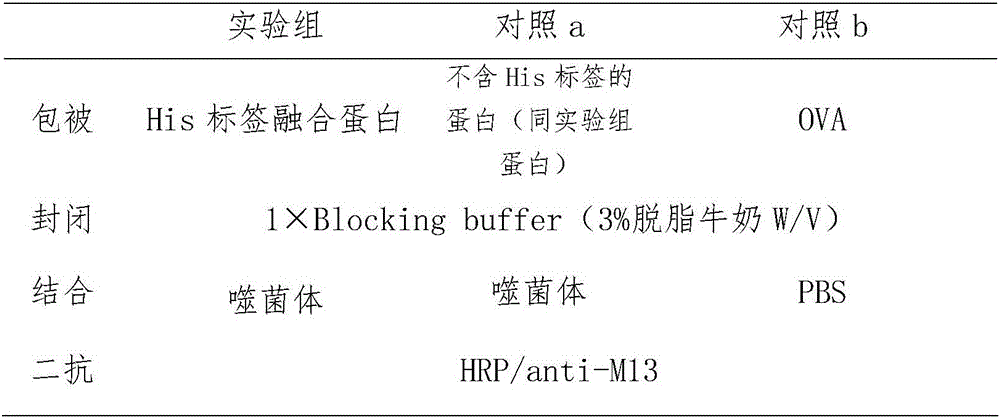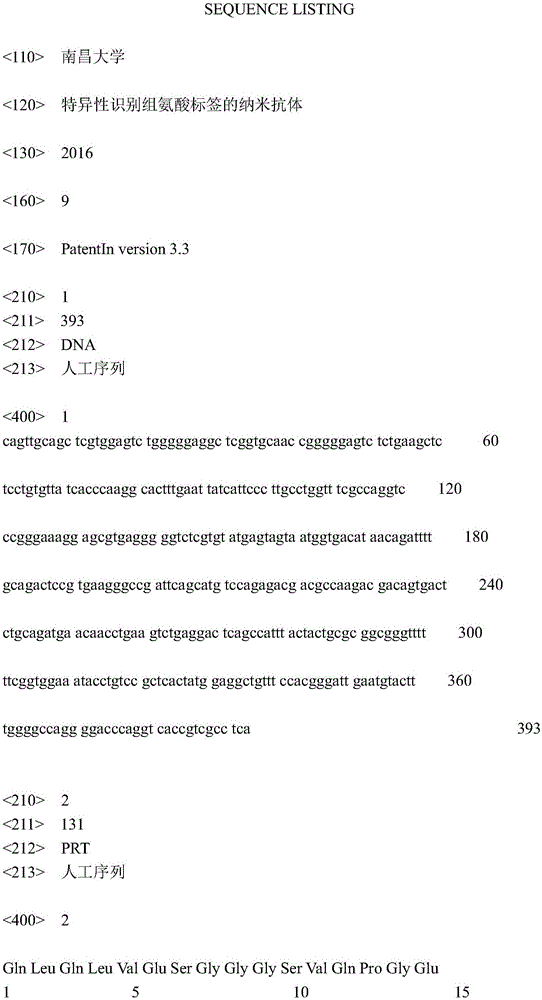Nano antibody for specifically identifying histidine label
A histidine tag, nanobody technology, applied in nanotechnology, nanotechnology, nanotechnology for materials and surface science, etc., can solve the complex, cumbersome development and production process of monoclonal antibody, and limited sources of polyclonal antibody And other issues
- Summary
- Abstract
- Description
- Claims
- Application Information
AI Technical Summary
Problems solved by technology
Method used
Image
Examples
Embodiment 1
[0022] Construction of an immune library of anti-His tag single domain heavy chain antibody (that is, single domain heavy chain antibody against His tag)
[0023] The 6×His tag was covalently coupled to bovine serum albumin (BSA) to obtain 6×His artificial antigen 6×His-BSA. After emulsifying 300 μg of 6×His-BSA with Freund’s complete adjuvant, Alpacas (Lamapacos) were immunized by subcutaneous multipoint injection. For booster immunization, 150 μg of 6×His-BSA was emulsified with Freund’s incomplete adjuvant at intervals of 2 weeks. Blood was collected from vein 7 days after each immunization, and the serum titer was determined by indirect ELISA method. The sample with the highest serum titer was selected to separate lymphocytes. cells, RNA was extracted.
[0024] The extraction of RNA was carried out according to the instruction manual of RNAiso reagent from TAKARA company. Using RNA as a template and oligo dT as a primer, the first strand of cDNA was synthesized according...
Embodiment 2
[0033] Panning and Identification of Anti-His Tag Single Domain Heavy Chain Antibody
[0034]The single domain heavy chain antibody against His tag was panned from the anti-His tag single domain heavy chain antibody immune library obtained in Example 1 by solid-phase affinity panning. 6×His was covalently coupled to ovalbumin (OVA) to obtain artificial antigen 6×His-OVA. Add 100 μL of artificial antigen 6×His-OVA diluted with PBS to each well, and coat overnight at 4°C. The coating concentration of each round of panning is 100, 75, and 50 μg / mL; suck out the coating solution, and wash the plate with PBS for 3 Add 300 μL 3% skim milk (in PBS) to each well, block for 2 hours at 37°C; wash the plate 6 times with PBS, add 100 μL phage antibody library (containing about 2×10 11 CFU), 37°C, incubate for 1.5 h; aspirate unbound phage, wash the plate with PBST (containing 0.5% Tween-20) 5 times (increase 5 times for each round), and then wash the plate with PBS for 10 times (the numb...
Embodiment 3
[0043] Scale production of anti-His tag single domain heavy chain antibody
[0044] Acquisition of the DNA fragment encoding the anti-His tag single domain heavy chain antibody: 1. Using restriction endonuclease SfiI / NotI, double digestion of phagemid pHEN-anti-His tag single domain heavy chain antibody gene, agarose gel electrophoresis Recover the anti-His tag single domain heavy chain antibody gene; 2. Directly send the anti-His tag single domain heavy chain antibody coding sequence to a biotechnology service company for chemical synthesis; 3. Design specific primers and use PCR technology from alpaca (Lama pacos ) was amplified from a cDNA library from the source.
[0045] The obtained anti-His tag single domain heavy chain antibody gene fragment was cloned into the expression vector pET25-flag (the His tag carried by the vector itself has been replaced with the Flag tag: DYKDDDDK), identified by PCR and enzyme digestion, and the anti-His tag single E. coli expression plas...
PUM
 Login to View More
Login to View More Abstract
Description
Claims
Application Information
 Login to View More
Login to View More - R&D
- Intellectual Property
- Life Sciences
- Materials
- Tech Scout
- Unparalleled Data Quality
- Higher Quality Content
- 60% Fewer Hallucinations
Browse by: Latest US Patents, China's latest patents, Technical Efficacy Thesaurus, Application Domain, Technology Topic, Popular Technical Reports.
© 2025 PatSnap. All rights reserved.Legal|Privacy policy|Modern Slavery Act Transparency Statement|Sitemap|About US| Contact US: help@patsnap.com



